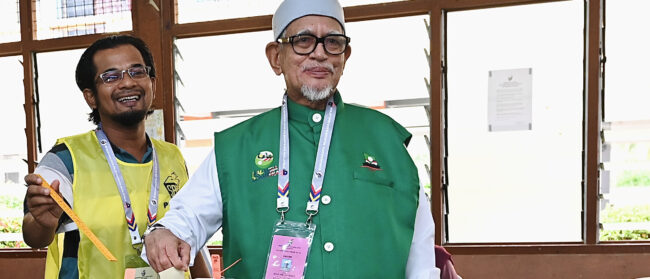The sound of two Mekong giant catfish torpedoing into the Tonle Sap River seemed to echo across the water. Conservationists hope their impact and presence does the same.
Hours earlier, the pair were named Champa and Sok, which mean ‘magnolia’ and ‘Friday.’ They were joined by more than 5,000 threatened fish that conservationists released into the confluence of the Mekong and Tonle Sap rivers in Phnom Penh on 13 January.
Research programme Wonders of the Mekong timed the release during fish migration season – which often begins in October and lasts until February – hoping to aid wild populations of critically endangered species. These include the iconic Mekong giant catfish and giant barb.
The decision to release the fish at the confluence in Phnom Penh was symbolic for Wonders of the Mekong, which was hosting the event to bring together its stakeholders. The programme itself is funded by USAID and involves the University of Nevada, Reno, the University of Agriculture in Phnom Penh and the Cambodian government. The Friday event’s primary goal was education and outreach, said Elizabeth Everest, a researcher with Wonders of the Mekong.



From left to right: Zeb Hogan, associate professor at the University of Nevada-Reno, Neth Pheaktra, secretary of state for the Ministry of Environment, Has Sareth, secretary of state for the Ministry of Agriculture, Forestry and Fisheries.
While a portion of the fish may be caught by fishermen downstream, according to associate professor at the University of Nevada-Reno, Zeb Hogan, their chances of survival are higher because of the end of dai fishing season and tags attached to many of the fish instructing people to release them.
For most of the year, Tonle Sap River runs south from Tonle Sap Lake to Phnom Penh, where it joins the larger Mekong. During monsoon season the Mekong’s water levels rise so much that flow of the river reverses in a unique ‘flood pulse’ that swells the lake to a much-larger surface area. As rains drizzle out and water levels ebb, the river reverses again. This is when the migration begins.
Hogan said the fish released last week will hopefully bolster populations in “incredibly important areas for fish spawning, fish production and biodiversity that helps support food and livelihoods for people throughout Cambodia, Vietnam and Laos.”
The Mekong River Basin faces a variety of threats, from climate change and hydropower dam development to sand mining and over-fishing.
“We face climate change and other developments that create the loss of endangered fish and today we celebrate the fish release ceremony which is of vital importance,” said Has Sareth, secretary of state for the Ministry of Agriculture, Forestry and Fisheries.
Across the basin, these factors have strained fish stocks that conservationists are now trying to bolster across Cambodia. Wonders of the Mekong hosted the largest fish release on Tonle Sap Lake in March of last year.
“The fish release is an important message that highlights the importance of fish conservation especially endangered fish to make them repopulate to avoid…extinction in Cambodia,” said Neth Pheaktra, secretary of state for the Ministry of Environment, who then explained plans to apply to UNESCO to have portions of the Mekong upstream recognized as a natural world heritage site.
Hundreds of the released fish were tagged and Pheaktra implored that “If you catch them because they are very valuable… Please understand and please do not eat or kill them. Put them back in the river to let them spawn.”
Photos by Anton L. Delgado for Southeast Asia Globe. Additional reporting by Sophanna Lay.









